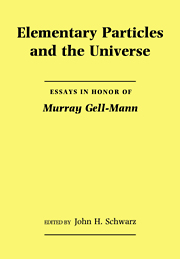Book contents
- Frontmatter
- Contents
- Preface
- Excess Baggage
- Through the Clouds
- Covariant Formulations of the Superparticle and the Superstring
- Chiral Symmetry and Confinement
- The Original Fifth Interaction
- The Mass Hierarchy of Leptons and Quarks as a New Symmetry
- Spacetime Duality in String Theory
- Supersymmetry and Quasi-Supersymmetry
- The Exceptional Superspace and the Quadratic Jordan Formulation of Quantum Mechanics
- Algebra of Reparametrization-Invariant and Normal Ordered Operators in Open String Field Theory
- Superconductivity of an Ideal Charged Boson System
- Some Remarks on the Symmetry Approach to Nuclear Rotational Motion
- Uncomputability, Intractability and the Efficiency of Heat Engines
- The New Mathematical Physics
- “Is Quantum Mechanics for the Birds?”
- The Gell-Mann Age of Particle Physics
- Remarks on the occasion of Murray Gell-Mann's more or less 60th Birthday
Covariant Formulations of the Superparticle and the Superstring
Published online by Cambridge University Press: 11 November 2009
- Frontmatter
- Contents
- Preface
- Excess Baggage
- Through the Clouds
- Covariant Formulations of the Superparticle and the Superstring
- Chiral Symmetry and Confinement
- The Original Fifth Interaction
- The Mass Hierarchy of Leptons and Quarks as a New Symmetry
- Spacetime Duality in String Theory
- Supersymmetry and Quasi-Supersymmetry
- The Exceptional Superspace and the Quadratic Jordan Formulation of Quantum Mechanics
- Algebra of Reparametrization-Invariant and Normal Ordered Operators in Open String Field Theory
- Superconductivity of an Ideal Charged Boson System
- Some Remarks on the Symmetry Approach to Nuclear Rotational Motion
- Uncomputability, Intractability and the Efficiency of Heat Engines
- The New Mathematical Physics
- “Is Quantum Mechanics for the Birds?”
- The Gell-Mann Age of Particle Physics
- Remarks on the occasion of Murray Gell-Mann's more or less 60th Birthday
Summary
Introduction
Supersymmetry is the first real extension of space-time symmetry. It has given us great hope that we should be able to generalize ordinary geometry into a super-geometry and in this process obtain more unique and consistent models of physics. In some cases this has been achieved, but in most cases we still lack a natural and unique extention into a superspace.
The concept of superspace, i.e., a space with fermionic coordinates as well as bosonic coordinates, was introduced first in dual models by Montonen in an attempt to construct multiloops in the Ramond-Neveu-Schwarz model. This led eventually to the superconformal algebras and super-Riemannian spaces. When supersymmetric field theories were discovered, it was soon realized that a super-space is the natural space in which to describe these models. However, these descriptions, although in the end quite successful in establishing renormalization properties, always lacked a certain sense of naturalness. For each supermultiplet different ideas had to be used.
In supergravity theories, being extensions of truly geometric theories, the hopes were even higher and the results more discouraging. So far one has only managed to write superspace actions for the N=1 theory, and none of them is a natural extension of the Hilbert action. Superspace techniques were though eventually useful in describing the classical theories and led to the really important result that any supergravity theory has infinitely many possible counterterms.
- Type
- Chapter
- Information
- Elementary Particles and the UniverseEssays in Honor of Murray Gell-Mann, pp. 23 - 40Publisher: Cambridge University PressPrint publication year: 1991

